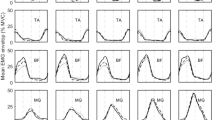Abstract
This study aims to clarify the relationship between handlebar and saddle heights on cycling comforts by assessing the kinematics, kinetics, physiological loading and subjective perceived exertion rating. Twenty young adults with mean age 24.6 years (SD=0.1) were recruited to participate in this study. A commercial city bike with the adjustable handlebar and saddle had been set on the indoor cycling stands. All subjects were asked to ride randomly with 9 different postures (3 handle ×3 saddle heights) for continuous one hour. A 3-D motion analysis system (Zebris Medical GmbH, Germany) was used to collect the kinematic data. The body pressure measurement system (Body Pressure Measurement System, Tekscan, U.S.A) was applied to measure the pressure distribution, force and displacement of centre of mass (COM). A heart rate monitor (Polar RS-800, Kempele, Finland) was used to record the heart rate as the physiological loading. Moreover, a subjective perceived exertion rating scale (Borg CR-10) was used to assess subjective comfort around the body regions. The results of this study indicated that the lower handlebar with higher saddle cause greater ROM in wrist-ulnar deviation, wrist extension, trunk flexion and hip abduction. It also reveals more force on hand region, more discomfort around hand, ankle and back, and higher physiological loading. While cycling with higher handlebar and lower saddle, it has more ROM in wrist flexion, more body displacement on buttock region, little trunk forward, and more discomfort rating in buttock region. For handlebar and saddle adjustment, the considerations of body dimensions and characteristics, the relationship between handlebar and saddle heights might improve the cycling comfort and diminish musculoskeletal injury.
Chapter PDF
Similar content being viewed by others
References
Dettori, N., Norvell, D.: Non-traumatic bicycle injuries: a review of the literature. Sports Medicine 36, 7–18 (2006)
Schwellnus, M.P., Derman, E.W.: Common injuries in cycling: prevention, diagnosis and management. SA Fam. Pract. 47(7), 14–19 (2005)
Wilson, C., Bush, T.R.: Interface forces on the seat during a cycling activity. Clinical Biomechanics 22, 1017–1023 (2007)
Author information
Authors and Affiliations
Editor information
Editors and Affiliations
Rights and permissions
Copyright information
© 2013 Springer-Verlag Berlin Heidelberg
About this paper
Cite this paper
Chiu, MC., Wu, HC., Tsai, NT. (2013). The Relationship Between Handlebar and Saddle Heights on Cycling Comfort. In: Yamamoto, S. (eds) Human Interface and the Management of Information. Information and Interaction Design. HIMI 2013. Lecture Notes in Computer Science, vol 8016. Springer, Berlin, Heidelberg. https://doi.org/10.1007/978-3-642-39209-2_2
Download citation
DOI: https://doi.org/10.1007/978-3-642-39209-2_2
Publisher Name: Springer, Berlin, Heidelberg
Print ISBN: 978-3-642-39208-5
Online ISBN: 978-3-642-39209-2
eBook Packages: Computer ScienceComputer Science (R0)




